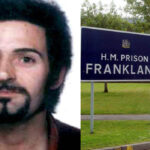“Nude in the Nettles”- Was it Sutcliffe?
By Tim Hicks and Chris Clark
Chris Clark is a retired Police Intelligence Officer with twenty eight years service, mainly working in police intelligence. For more information on Chris, please see his website here. Tim Hicks is our crime reporter and followed the Yorkshire Ripper investigation as a young man.
Their last article giving their assessment of the full range of Sutcliffe’s offending is below:
NYE: Yorkshire Ripper How Many Victims?
They believe it is the most up-to-date and accurate assessment of the number of attacks available to the public. They estimate that Sutcliffe murdered thirty-six women and attempted to murder another twenty-three in the period 1964 to 1981, including the “Nude in the Nettles” murder, which is the subject of this article.
No such estimate has ever been issued by the police.
In this article, they assess the possibility that Peter Sutcliffe (pictured above in his T.W. Clarke lorry in about 1976) committed a murder in North Yorkshire. This article reveals information they believe has not previously been revealed to the public by the police.
~~~~~
“Nude in the nettles” – Was it Sutcliffe?
Background: Unidentified Body at Sutton Bank, Thirsk. Known as the “Nude in the Nettles”.
One of the greatest mysteries in the history of North Yorkshire Police (NYP) started on Friday the 28th of August 1981, when responding to an anonymous telephone call, police from Thirsk discovered the decomposing body of a woman at Sutton Bank on the North York Moors.
Despite determined and relentless efforts, NYP have not been able to identify her. An appeal for information was made by NYP in 2011 as part of a cold case review thirty years after the discovery of the body as follows:
“An anonymous male caller telephoned North Yorkshire Police providing the exact location for police officers to search. On Friday 28th August 1981 Police officers attended the described location, a lay by on the unclassified road leading from Sutton Bank to the villages of Scawton and Rievaulx. The location is a quiet road used by local people and occasional caravaners heading to a nearby site. The rural area consists mainly of arable and pasture farmland with occasional conifer plantations. It was to the side of this road and between two small plantations that officers found the skeletal remains of an unknown female laid in undergrowth. This discovery marked the start of an 18 month police investigation led by Detective Chief Superintendent Strickland Maunsel Carter to establisher her identity and why she was there.
A forensic examination of the naked body revealed no jewellery or personal effects laid nearby that may assist in establishing who she was. A Home Office pathologist estimated she may have laid at that place situ for up to two years due to plant growth and state of the body. The post mortem did not establish a cause of death.
What could be established was that body was that of a female, 5’ 2” in height, aged between thirty five and forty and may have been a mother. The deceased appeared to have short dark coloured hair. There was evidence of an old fracture to the right ankle but nothing conclusive to provide an identification.
During the 18 month police investigation extensive enquires were conducted and a number of people were identified as possible matches for the deceased but none could be positively identified as the deceased.
A line of enquiry reported on at the time related to a female prisoner that had escaped from Askham Grange open prison almost two years earlier but has not been seen since or spoken to by police.
Thirty years later the same questions remain. The anonymous male caller that started this 30 years police investigation may have the answer to the other questions – who is this lady left undiscovered at the top of Sutton Bank?, what was she doing there? and how did she die.
The thirty years that have elapsed since the discovery of this lady has seen significant developments in police technology that are used in current police investigations, and possibly viewed as normal enquiries.
At the time a three-dimensional wax reconstruction of her head, which was first such reconstruction, indicated the investigators were keen to use new technology. It was a positive actions as the circulations of this image generated significant interest and possible identities but these failed to provide the identification required.
We need to recognise that at the time of her discovery the Police National Computer that holds vehicle and person details was in its infancy, The Automatic Number Plate Recognition (ANPR) had not been invented and the first mobile telephone call to be made in the UK would not take place for another three and half years.
Although the passage of time has changed police technology, North Yorkshire Police’s commitment to finding the answers to these questions remains the same, so that her family can have the answers they deserve. For this reason if you know the identity of the lady or the male caller please make contact.”
This appeal was closely coordinated with the local media, who were commendably supportive of police efforts to try and resolve the case. Article by Jennifer Bell of York Press here. Subsequently in 2012, North Yorkshire Police exhumed the body and extracted DNA from it. This was done with dignity and due reverence. This is covered in this Yorkshire Post article by Rob Preece. Both of the above excellent articles obviously had police input and revealed additional information to that disclosed above. Four passages from the Jennifer Bell article are very relevant. The caller said :
“Near Scawton Moor House you will find a decomposed body among the willow herbs”.
It was a yoghurt top, discovered beneath the body, which gave police a vital timeline of clue of how long she had lain there –about two years.
The position of the body suggests someone was in a hurry to dump her.
Another popular theory was that the woman was a prostitute. But whoever she was police are convinced to this day that the cause of death was unnatural.”.
The original investigation 1981 – 1983
The authors have re-examined the facts of the case, using open sources and information provided by some members of the original investigation.
(1) Premature identification of a prime suspect
Instead of being open minded about the identity of the caller and adopting a TIE (Trace, Implicate or Eliminate) strategy, the investigation immediately jumped to the conclusion that the caller was an “immediate suspect”.
Both authors believe the caller had innocently found the body and wanted to let the police know, but was afraid to reveal his identity, perhaps for fear of becoming a suspect. Then being held in a police station overnight and interrogated, having his home searched and the damaging publicity, or having an extra marital affair revealed.
The aggressive approach by the police of declaring the caller a prime suspect straight away, no doubt –and understandably- confirmed to him that not coming forward was his safest option.
Had the investigation taken a more open minded, empathetic approach, by issuing assurance that they only wanted to speak to him. There would have been a better chance that he would have declared himself to police.
(2) The yoghurt top hypotheses
The investigation team therefore based the date of death on a yoghurt top found underneath a body, presumably from a few weeks before the sell-by date. The implication being that the date the body was dumped was after the date that the yoghurt was sold.
This led them to the conclusion that the date the body was dumped at Sutton Bank was a certain date in 1979.
It did not consider the possibility that the yoghurt top had been placed there deliberately as a decoy to confuse the investigation over the time of death.
(3) Failure to consider Peter Sutcliffe as a suspect
The Yorkshire Ripper investigation in 1975 – 1981, was up to that time the biggest police investigation ever undertaken in Britain. Peter Sutcliffe – a married lorry driver from Bradford – was convicted of murdering thirteen women and attempting to murder another seven between 1975 and 1980.
For those that are unfamiliar with the Yorkshire Ripper case, there is a very good documentary here.
Peter Sutcliffe was arrested and convicted in 1981 of seven attempted murders and thirteen murders.
A member of the original investigation team has confirmed to the NYE that he has no recollection of Peter Sutcliffe being mentioned to him as a potential suspect. This is to some extent understandable prior to December 1981 because:
- In August 1981 when the body was discovered, Sutcliffe’s geographical area of operations was believed to be in the West Yorkshire Police(WYP), South Yorkshire Police (SYP) and Greater Manchester Police (GMP) areas.
- Whilst the victim was suspected to be a prostitute, the crime scene did not bear the usual hallmarks of a Ripper attack as far as they were known at that time.
- The length of time the body had lain out in the open and interference by animals removed a lot of the forensic evidence, made it difficult to draw parallels with Sutcliffe’s various modus operandi.
However, following Sutcliffe’s trial, the Home Office tasked Chief Constable Lawrence Byford of HM Inspectorate of Constabulary to conduct a review of the WYP Yorkshire Ripper investigation. It was published in December 1981, three months after the discovery of the body. Sir Lawrence found there was an “unexplained lull” in the Ripper’s activities between 1969 and 1975:
“We feel it is improbable that the crimes in respect of which Sutcliffe has been charged and convicted are the only ones attributable to him. This feeling reinforced by examining the details of a number of assaults on women since 1969 which in some ways, clearly fall into the established pattern of Sutcliffe’s overall modus operandi…”
“It is my firm conclusion that between 1969 and 1980 Sutcliffe was probably responsible for many attacks on women, which he has not admitted, not only in West Yorkshire and Manchester but also in other parts of the country….”
With the publication of the Byford Report it was known that Sutcliffe’s geographical area of offending extended beyond the WYP, SYP and GMP areas. This should have had a dramatic impact on the investigation:
- The year 1979 was at the height of the Yorkshire Ripper’s reign of terror, which only ended when Sutcliffe was arrested in January 1981 in Sheffield.
- Sutcliffe was known to have driven to Sunderland and Scarborough regularly; he also travelled to Darlington and Newton Aycliffe. His routes took him close to the place where the body was dumped.
- Sutcliffe’s geographical area of operations was then known to be much wider and included North Yorkshire. NYP had already considered the possibility that an attack in Harrogate on the 17th of February 1979 was perpetrated by the Yorkshire Ripper.
- The “Nude in the Nettles” investigation assessed that the deceased may have been a prostitute. Peter Sutcliffe was known to attack prostitutes.
These facts taken together should have made him a prime suspect, but he was ignored. The decision to focus on the caller as the prime suspect ruled Sutcliffe out, because he was in jail at the time the call was made.
The “Nude in the Nettles” investigation was closed in early 1983, with the mystery caller firmly established as the prime suspect. He was maintained as the prime suspect in the 2011 cold case investigation.
Elimination of the mystery caller as a suspect

Aerial photograph of the location of the body (A) and Scawton Moor House (B)
Although it is possible that the caller was involved in the murder, he seems to the authors to be a very unlikely prime suspect:
- Given that there was no possibility of the body being moved and he knew the body had not been discovered because if the lack of press coverage. There is no rational basis to assert that the murderer visited the site to check the body was still there.
- There is no realistic prospect that after two years, the murderer rang the police to provide the location, knowing this would initiate a murder investigation that could lead to his arrest.
- The caller is only linked to the discovery of the body, not the crime, which was committed two years before in another location.
- His actions and comments on the telephone are entirely consistent with him having innocently discovered a body and reporting it anonymously to avoid getting involved.
Both authors are convinced that the caller was an innocent person who wanted to let the police know about the body without getting involved. We are divided on theories about who the caller was. These are some of them:
- The discovery was made by a serviceman or a group of servicemen, who -unsure of what to do- notified an officer. The officer returned with the men and verified the location of the body. He decided that he did not want the identity of his men revealed for reasons of national security – perhaps they were from special forces, or RAF Fylingdales (USAF or RAF), or the GCHQ listening post at Scarborough – so he rang the police giving a six-figure grid reference (standard army procedure) and a description of the location. This explains the caller being well-spoken, the tracks, the map, the six-figure grid and the description being so accurate that police were able to find the body that day.
- The discovery was made by an experienced rambler or a group of ramblers, with an interest in wild life and plants walking in the area. This explains the map, grid reference, description with the name of the plant “willow herbs” (rather than “pink flowers and nettles” to a non-countryman) being so accurate.
- Sutton Bank was used by walkers, picnickers, caravaners courting couples and shooting parties. The discovery could have been made by:
- A couple (possibly having an extramarital affair) looking for a place to have sex.
- Friends that were shooting.
- A child wandering off from a family picnic or caravan to explore, play or urinate.
- A couple walking their dog.
One person found the corpse, returned and told the other(s) who returned, thereby explaining the tracks.
Why we believe the “Nude in the Nettles” is one of Peter Sutcliffe’s victims
According to the information released to the press by the police at the time, the police were following a line of enquiry that the deceased was a prostitute. Truck stops in North Yorkshire at the A1 Services Boroughbridge and the A168 Thirsk were places where in the late 1970’s, prostitutes and “truck hoppers” abounded, and worked the lorry parks. Sunderland, Darlington, Hartlepool, Middlesbrough and Newcastle all had red light districts. According to a local man who lived in Scarborough at that time “there was no ‘red light district’ in Scarborough, as such,but there were prostitutes operating out of flats and cottages in the old town – the so-called ‘Bottom End’. The notorious Coates family used to run prostitutes into Scarborough from Middlesbrough, and vice versa”.
The authors consider that Sutcliffe should be considered as a suspect in the “Nude in the Nettles” murder because:
- Sutcliffe’s work as a lorry driver took him regularly to Scarborough. The direct route from Bradford uses the A64, but it is possible he also used the A170 to make subsequent deliveries after Scarborough.
- Examination of the aerial photograph above shows that if he did take the A170, he would have seen the place where the body was found. Sutcliffe amassed a collection of A-Z maps of cities in Britain and had a very good knowledge of road routes. He was topographically aware and could have noted the location as a useful site to take a body.
- Sutcliffe also drove regularly to Sunderland Docks. His route to Sunderland from Bradford was probably via the A658 to the A1(M) North, the A168 through Topcliffe and the A19 at Thirsk where he could continue North on the A19 to Sunderland, or take the A170 to Sutton Bank, or on to Scarborough.
- Sutcliffe also drove to Newton Aycliffe and Darlington and may have used the A19 route – with its convenient short diversion to Sutton Bank – for these journeys.
- Sutcliffe could easily have used the red light districts in Sunderland, Darlington, Hartlepool, Middlesbrough and Newcastle to trawl for victims. There has recently been press comment that Sutcliffe may have been responsible for the murder of Stephanie Spencer who was battered to death near a lorry park in Darlington on Saturday the 29th of May 1977. He may have had to dump a body on the return journey to Bradford.
- Sutcliffe stabbed some of his victims to death and this is detectable if the knife had struck bone. All of the bones were examined carefully and no such injuries were found. So it is possible a knife passed between the ribs, or the deceased was stabbed in the stomach.
- Sutcliffe used a ligature on some of his victims. Ligature strangulation may occasionally break the little bones of the voice box and hyoid. These were missing from the body because of the activities of wild animals, so strangulation could not be ruled out. There was no material around the throat, but when he used a ligature, Sutcliffe always removed it with him.
- By 1979, West Yorkshire Police surveillance of red light districts was intense. Sutcliffe had changed his geographical area of operation to Sheffield when he was arrested in 1981, possibly to evade it. He may also have changed his area of operations to commit the “Nude in the Nettles” murder in North Yorkshire for the same reason.
- Sutcliffe occasionally destroyed his own bloodstained clothes after a murder by burning them with garden rubbish to destroy forensic evidence. He may also have destroyed the clothes of a victim in the same way.
Sutcliffe was forensically aware and deliberately changed his modus operandi to confuse the investigation as to which crimes were his and which were not. The “Nude in the Nettles” case is not typical of Sutcliffe’s crimes. Sutcliffe’s victims were often posed, he usually did not fully undress the bodies. A hammer blow to the back of the head was the usual Sutcliffe signature but there was no evidence of skull injury in this case. However, there are similarities between the “Nude in the Nettles” murder and some of his other attacks:
- Yvonne Pearson’s (murdered on the 22nd of January 1978), body was concealed (for two months) and there was a document (a copy of a newspaper dated February the 21st) under the body. Sutcliffe denied that he had returned to the body to place the paper there at a later date, to confuse the investigation as to the date of death. Although that can be the only explanation.
- Jean Jordan (murdered on the 1st of October 1977) was left nude. Sutcliffe returned to the scene to search for a £5.00 note he had given her, fearing it would be traced to him through the number and lead to his arrest. He stripped the body, leaving the clothes scattered around, then mutilated it. He also used different weapons (a ¾ pane of glass and a hacksaw) to vary his modus operandi and confuse the investigation. He has been quoted as saying: “before I did this it was my intention to create a mystery about the body,”.

Diagram showing where Sutcliffe left Jean Jordan’s clothing
- Tracey Browne was attacked on the 27th of August 1975 in a similar rural location and left for dead.
- Debra Schlessinger was stabbed to death on the 21st of April 1977 without use of a hammer.
- Sutcliffe used a ligature in the attacks on Marguerite Walls on the 20th of August 1980 and Upadhya Bandara on the 24th of September 1980. When he was arrested in 1981, he was in possession of a ligature.
In summary, the victim, body and crime scene are consistent with Sutcliffe’s MO, he probably knew the place where the body was dumped and he may have been in the vicinity at the time. Thus, he should have been a suspect, but was ignored by both investigations.
So where do we go from here?
The authors have issued a Freedom of Information Request asking for sight of the NYP Nude in Nettles investigation file.
The authors have provided NYP with sight of this article and requested a joint press release to try and obtain information on the basis of a fresh line of enquiry, even at this late stage
Typically, we have received no response by our publication deadline.
NYE Appeal for information on “Nude in the Nettles” mystery
The Victim

Three-dimensional wax reconstruction of the victims head and face
- She was 5’ 2” in height, aged between thirty-five and forty.
- She had a slender build and wore her natural dark brown hair in a page-boy style.
- She had given birth to two or three children and had a displaced septum between her nostrils.
- Her toenails were painted pink – the varnish coming from the Max Factor ‘Maxi’ range.
- She would have worn a size four shoe.
- Staining on her teeth revealed that she was a heavy smoker that did not look after herself.
- All her upper teeth were missing; she had an upper dental plate fitted, and she had only six lower teeth.
- She had an old fracture to her right ankle and an abnormality to her neck vertebrae which would have caused backache.
- Sutcliffe was forensically aware and always removed his weapons from the crime scene. No weapon was found at Sutton Bank.
To jog memories, 1979 was the year Margaret Thatcher was elected, the Ayatollah Khomeini returned to Iran, “Heart of Glass” by Blondie and “I will survive” by Gloria Gaynor were in the charts.
- Do you remember someone like this from 1979?
- Did she come into Scarborough or Whitby on a yacht?
- Did you see her hitch-hiking?
- Did you see her in a truck stop at the A1 Services at Boroughbridge, the A168 at Thirsk, or the Leeds, Manchester, Halifax, Bradford, Sunderland, Darlington, Hartlepool, Middlesbrough or Newcastle red light districts?
- Did you see her walking on the North York Moors?
Peter Sutcliffe

- Did you see Peter Sutcliffe (pictured above) in Scarborough or any of the above locations?
- Did you see a lorry from TW Clarke (image at top of the article) in Scarborough or any of the above locations?
- Did you see anyone behaving suspiciously along the A170 or at Sutton Bank in the period 1978 to August 1981?
- Did you find women’s clothes discarded along the A170 in 1979?
If the answer to any of the above questions is “yes”, or if you have any information on the “Nude in the Nettles” mystery that you want to pass on confidentially, you can talk to a journalist by initially contacting the North Yorks Enquirer using our news@nyenquirer.uk address, with the words ‘NUDE IN THE NETTLES’ in the subject line.
All responses will be treated in the strictest confidence.
Coming Next
“The Harrogate Ripper – Was it Sutcliffe?”
Further reading
gazetteherald.co.uk, 14 March 2012
Murder and Mysteries of the North York Moors
NYE Sir Lawrence Byford Obituary
NYE Book Review: Yorkshire Ripper The Secret Murders




![“On the Trail of the Yorkshire Ripper” [Book Review]](https://nyenquirer.uk/wp-content/uploads/2020/06/RIPPER_TRAIL-150x150.jpg)








